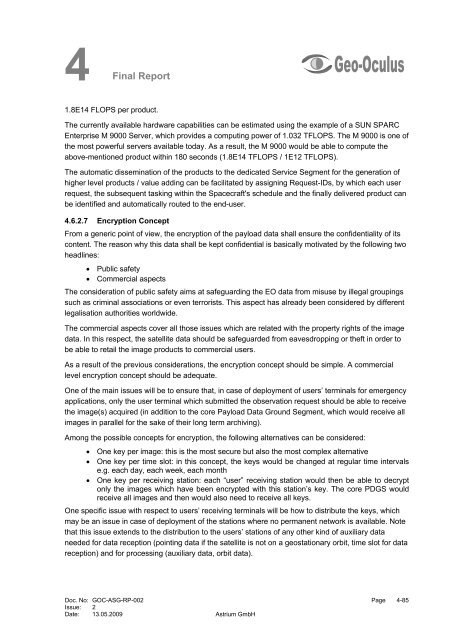4 Final Report - Emits - ESA
4 Final Report - Emits - ESA
4 Final Report - Emits - ESA
You also want an ePaper? Increase the reach of your titles
YUMPU automatically turns print PDFs into web optimized ePapers that Google loves.
4 <strong>Final</strong><br />
<strong>Report</strong><br />
1.8E14 FLOPS per product.<br />
The currently available hardware capabilities can be estimated using the example of a SUN SPARC<br />
Enterprise M 9000 Server, which provides a computing power of 1.032 TFLOPS. The M 9000 is one of<br />
the most powerful servers available today. As a result, the M 9000 would be able to compute the<br />
above-mentioned product within 180 seconds (1.8E14 TFLOPS / 1E12 TFLOPS).<br />
The automatic dissemination of the products to the dedicated Service Segment for the generation of<br />
higher level products / value adding can be facilitated by assigning Request-IDs, by which each user<br />
request, the subsequent tasking within the Spacecraft's schedule and the finally delivered product can<br />
be identified and automatically routed to the end-user.<br />
4.6.2.7 Encryption Concept<br />
From a generic point of view, the encryption of the payload data shall ensure the confidentiality of its<br />
content. The reason why this data shall be kept confidential is basically motivated by the following two<br />
headlines:<br />
• Public safety<br />
• Commercial aspects<br />
The consideration of public safety aims at safeguarding the EO data from misuse by illegal groupings<br />
such as criminal associations or even terrorists. This aspect has already been considered by different<br />
legalisation authorities worldwide.<br />
The commercial aspects cover all those issues which are related with the property rights of the image<br />
data. In this respect, the satellite data should be safeguarded from eavesdropping or theft in order to<br />
be able to retail the image products to commercial users.<br />
As a result of the previous considerations, the encryption concept should be simple. A commercial<br />
level encryption concept should be adequate.<br />
One of the main issues will be to ensure that, in case of deployment of users’ terminals for emergency<br />
applications, only the user terminal which submitted the observation request should be able to receive<br />
the image(s) acquired (in addition to the core Payload Data Ground Segment, which would receive all<br />
images in parallel for the sake of their long term archiving).<br />
Among the possible concepts for encryption, the following alternatives can be considered:<br />
• One key per image: this is the most secure but also the most complex alternative<br />
• One key per time slot: in this concept, the keys would be changed at regular time intervals<br />
e.g. each day, each week, each month<br />
• One key per receiving station: each “user” receiving station would then be able to decrypt<br />
only the images which have been encrypted with this station’s key. The core PDGS would<br />
receive all images and then would also need to receive all keys.<br />
One specific issue with respect to users’ receiving terminals will be how to distribute the keys, which<br />
may be an issue in case of deployment of the stations where no permanent network is available. Note<br />
that this issue extends to the distribution to the users’ stations of any other kind of auxiliary data<br />
needed for data reception (pointing data if the satellite is not on a geostationary orbit, time slot for data<br />
reception) and for processing (auxiliary data, orbit data).<br />
Doc. No: GOC-ASG-RP-002 Page 4-85<br />
Issue: 2<br />
Date: 13.05.2009 Astrium GmbH

















